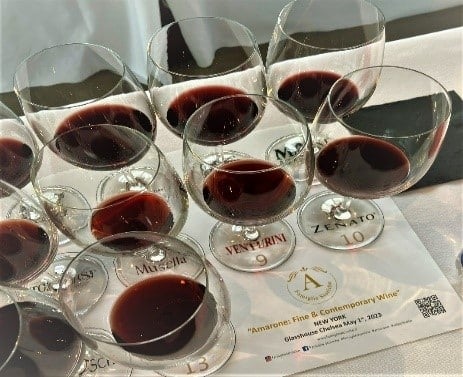Producing Amarone – from the terroir through the long finish is a multifaceted process and adventure that embraces tradition, science, culture, economics, and market demand.
OOPS
Folklore suggests that Amarone was produced by chance and not design; an over-extended fermentation process of Recioto enabled the yeast to consume most of the sugar content and the outcome produced a drier wine with a high alcohol by volume (ABV) percentage. The outcome? The birth of Amarone, a brand-new wine.
File Under Who Knew
Amarone (Italian = Big Bitter) wine is produced in Italy and the technique of dehydration has been popular since the Romans used the method in the production of Rhaetian wine (sweet wine produced in the hills around Verona). In 1600 BC (Ancient Anatolia) the technique became popular throughout the Greco-Roman classical world.
The first written evidence explicitly mentioning the production of wines using partially dehydrated Valpolicella grapes in Verona dates to the fifth century, in a letter written by Cassiodorus, King Theodoric’s minister in Ravenna to the senators of the Venetian canonry, seeking to obtain the procurement of a Sweet, Reinforced and Fortified Wine.
Natural sun drying, whether on or off the vine is still considered the most traditional and commonly used method for withering grapes in many Mediterranean countries. Amarone (as a name) first appeared on bottle labels from the Veneto region in 1939; however, the wine was not produced on a regular basis until 1953 and, the Denominazione di Origine Controllata (DOC) status was not assigned until December 1990.
Rules
Because Amarone is a DOCG wine the production process must follow a set protocol (some mandatory; others optional):
A. Mandatory
1. Grape selection (autochthonous/indigenous/local cultivars include)
· Corvina + Corvinone (45-95 percent)
Corvina is the signature grape (Corvo = crow) because ripe berries are very dark, almost bluish recalling the plumage of the bird. Grapes produce oval berries with good acidity and medium tannins. Amarone produces a wine with a ruby red color, longevity, and hints of red fruit.
· Corvinone. An independent varietal. Berry size is an advantage in terms of yield and speeds harvesting; gives Amarone structure and spicy notes
· Rondinella (5-30 percent)
(Italian = little swallow; or due to V shape leaf resembles the tail of a swallow; or because birds appreciate the small berries; or the color recalls the swallow’s coat color). Berries are smaller than other grapes (round and dark colored), with a thick skin; delivers aromatic notes with hints of red fruit and floral scents.
B. Optional (beginning in 2003)
· Molinara (Italian = miller)
Due to the consistent quantity of pruine, (a natural yeast on the berries’ skin), bunches look like they have been sprinkled with flour. Light in color, the skin is pink and almost transparent. Nicknamed salty grape because of its low acidity and low tannins. Gives Amarone a fresh mineral note.
Hand Harvesting. Traditional Methods
Read more: Amarone. Not Shriveled: Withered
Copyright: eTurboNews is Travel Industry News – Travel & Tourism Story Telling Exposed





